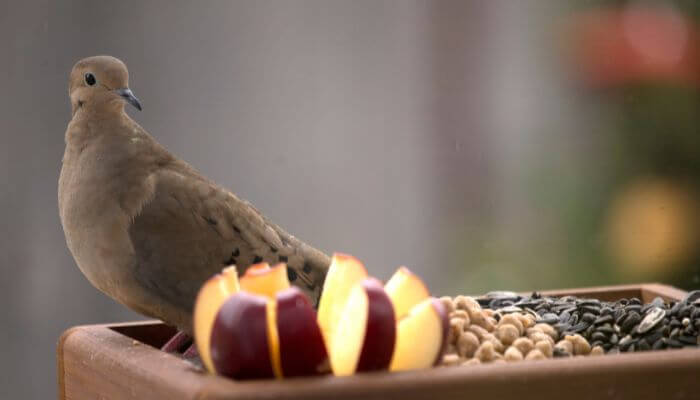Members of the Columbidae family (pigeons and doves) are primarily granivorous (grains and seeds) or frugivorous (fruit and berries). Mourning doves are granivores.
The mourning dove is one of the most common birds of North America and has numerous equivalents around the world. It is widespread across the USA, Canada and Mexico and even into Central America.
The widespread distribution means that while their feeding habits are generally the same, they may vary according to the different habitats and climates in different regions.
Feeding Habits of the Mourning Dove

Mourning doves are ground-feeding birds. They forage by walking along the ground, pushing aside leaves and debris to find food.
They do not dig or scratch and only eat what is readily visible.
Occasionally, they may perch on a plant to eat its seeds.
They only pick up and fill their crop then fly to somewhere safe to digest the food.
It is known that mourning doves are a species that eat grit (fine gravel or sandy lumps) to aid digestion.
The bird can eat 12-20 percent of its own weight every day – something around 70 calories.
The Diet of the Mourning Dove
Seeds make up 99 percent of what a mourning dove eats.
Their diet is one of the largest ranges of seed types of any bird in North America.
Top of their list are:
- sunflower seeds
- millet
- corn
- rapeseed
- safflower
Others actively sought are:
- sweetgum
- pokeberry
- amaranth
- wheat
- canary grass
- sesame
- pine nuts
Others:
- buckwheat
- smartweed
- goosegrass
- rye
While they do prefer seeds, they will eat the green part of grasses, weeds, and herbs.
When their favorite foods are absent, they might eat peanuts or the occasional berry.
Mourning doves are not particularly fond of insects and other invertebrates but will eat them when no other food is available.
What Do Baby Mourning Doves Eat?

As with most pigeon and dove species, both parents take responsibility for feeding a hatched chick.
The chick is fed crop milk. This is similar to fine cottage cheese in consistency and is very high in fat and protein as well as being rich in beneficial antioxidants.
Crop milk is made inside the parent’s crop (a portion of the esophagus that stores food before digestion), where proteins are infused with fatty cells from the lining of the sac.
Baby doves eat crop milk exclusively for the first week of their lives, after which the parents will start to introduce other items like softened seeds which become the norm after about three weeks until the dove leaves the nest.
Do Mourning Doves Migrate For Food?
Any creature that migrates does so either for breeding in more hospitable climes or for a better food resource when the weather makes it scarce.

Mourning doves migrate for food and not to breed.
They are also what are known as partial migrators.
As they live all over North America, not all populations need to migrate from areas of harsher climes to find food in winter.
Doves who live in the northern regions of the United States and Canada are driven to migrate to more southern locations for access to food.
How Can You Attract Mourning Doves To Your Garden?
If you are eager to attract mourning doves into your garden, then the best plan of action is to provide the foods that they like the most, in ways that are going to be most accessible and enticing to them!
It is relatively easy to attract the mourning dove in for a quick snack.
Any high-quality food mix for wild birds will do the trick, but if you are looking for specifics to make your own mixture then some of the best items for mourning doves include:
- safflower seeds
- sunflower seeds (unshelled).
- peanuts (unshelled)
- millet
- cracked corn.
If you want to plant an area to specifically attract mourning doves, sow plants like doveweed, foxtail, Colorado grass, sorghum and plains bristlegrass.
What Feeders Are The Best For Mourning Doves?

Mourning doves do the vast majority of their feeding on the ground. They have a much tougher time of it when they a required to maneuver around tight spaces like dense trees.
This kind of problem transfers to garden feeders that might have small perches. Sadly, they are just a little bit too clumsy to keep their balance on such a structure!
Large platform feeders and hopper feeders are both able to comfortably accommodate a clumsy mourning dove!
If things tend to get competitive around your feeder platforms in the garden, then don’t be surprised to see a mourning dove retreat and take to a ground feeder instead.
Given their natural habit of floor foraging, they tend to be more comfortable with this kind of set-up anyway.
If doves are happier dropping to the ground under a feeder to salvage the dropped seeds, then put a dedicated ground feeder down instead.
However, if you are interested in being able to sit back and watch the birds as they feed, then all you need to do is make sure that you have a feeder in place with enough space for them to comfortably perch and remain balanced.
To boost your enjoyment of the event, the good news is that mourning doves will usually eat in pairs, so if you can achieve the right kind of setup you will end up getting two for the price of one!
